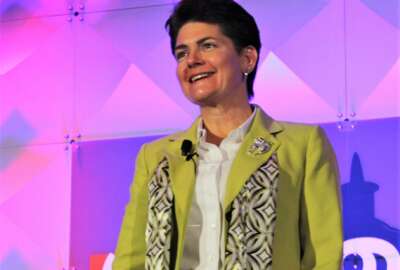Going back to in-person federal IT conferences brings renewed energy
Imagine Nation, the annual leadership conference put on by the American Council for Technology Industry Advisory Council, returned to in-person earlier this wee...
Best listening experience is on Chrome, Firefox or Safari. Subscribe to Federal Drive’s daily audio interviews on Apple Podcasts or PodcastOne.
Imagine Nation, the annual leadership conference put on by the American Council for Technology Industry Advisory Council, returned to in-person earlier this week. Known by the shorthand ACT-IACT ELC, the confab brings together top federal IT officials and executives from tech contractors. It concluded yesterday in Hershey, Pennsylvania. Federal News Network’s Tom Temin was there and he joined Jared Serbu for his impressions of this not-quite-post-COVID event.
Interview transcript:
Jared Serbu: Hey there, Tom, welcome to the Federal Drive with Tom Temin.
Tom Temin: Yes, it’s funny coming in from this way, but good to talk with you, Jared.
Jared Serbu: So as we say, this was this was really the first ELC since the beginning of the pandemic. I imagine it was nice for people to see each other in person for the first time in a long time in a lot of cases. What was the general vibe?
Tom Temin: The vibe was really, really positive. I got there late. But when I walked into the lobby, the post-dinner reception was going, and it was just a mob scene – loud, crowded, laughing. I mean, people, in the next morning, I was seeing a lot of people I had not seen in a couple of years. And there were hugs all round. People were really, really glad to get together and just see one another in person. I was surprised at how positive the vibe really was.
Jared Serbu: And among the folks I know you talked to was GSA Administrator Robin Carnahan. Was she actually – in attendance at the conference, what did she have to say?
Tom Temin: Well, she was not in attendance, and nobody from the General Services Administration was in attendance because they are on no-travel policy. So it wouldn’t look good for Carnahan herself to travel to Washington from her home in Missouri. She was the Secretary of State for the state of Missouri, among her earlier jobs, but so she was not in person. I was talking to her via a large screen. And she basically said that she wants to keep GSA on the trajectory it’s going on. They want to do some improvements to SAM.gov. Even though it’s out of the beta site stage, she said that she is going to still listen to industry to keep trying to improve that. She said, in general, GSA needs to be easier for companies to do business with. That is to say not necessarily to sell to GSA, but to get onto the GSA vehicles, and so on and sign up through the – say, the schedules program, and she wants to continue making that easier. And she said, GSA itself does need to be a better buyer of the goods and services it needs. And she says that means a lot of tightening up of requirements, and not trying to be so prescriptive. So pretty classic stuff.
I should note, she was at GSA during the Obama administration, when she was running the 18F program – not running the whole [program] – when she was running a section of the 18F program concerned with state and local government. And she said she will pay a lot of attention to 18F this time around, but she said that central mission of 18F is still just to basically deliver software that works.
Jared Serbu: And even if Robin Carnahan wasn’t there in person, what we’ve heard back here is that there were an awful lot of agencies, CIOs there, and I think there was an agency CIO panel in fact. What were some of the consensus issues during that session beyond some of the issues raised by the pandemic itself, which seems to have been one of the one of the big things that all agency CIOs have been talking about lately?
Tom Temin: Yeah, that panel was half-and-half. Gary Washington, the CIO of the Agriculture Department, and Ann Dunkin, the CIO of the Energy Department, were in person. Guy Cavallo, the the CIO of the Office of Personnel Management, and Gundeep Ahluwalia, the Labor Department CIO, those two were virtual. But they talked about the TMF. And interesting gives the Labor Department has had some TMF money. At OPM Guy Cavallo said, if they don’t get TMF – Technology Modernization Fund money – then they will simply be able to keep the lights on but will not be able to proceed with the desperate need of modernization that OPM has with all of its mainframe systems. Ann Dunkin said that the the executive order on cybersecurity has really caused a great focus on things that were already happening.
I mean, with respect to the executive order, all of the CIOs said, well, they were already going to zero trust, they were already looking at two-factor authentication and all of the other measures called for, but they did say, pretty much agree that it forces much greater collaboration, both within the agency and across agencies, and that it served to focus leadership, say, at the deputy secretary level to focus on cybersecurity. So they were pretty positive about that. But everybody wants that TMF money. Ann Dunkin said, for the Energy Department, it would be a down payment if they were to get some of that TMF money. So kind of the old story: Money is great, but not enough.
And also speaking at one of the keynotes during a luncheon session was Harrison Smith. He’s the director of the Enterprise Digitization and Case Management Office at the IRS. And they have really taken the bull by the horns there to try to get some modernization deep into the processes of IRS. And he said they’ve really come up with some new criteria. For whether they go ahead with a project in the first place, and one of the things he said is if they can’t prove a return on investment in a very highly defined period of time, they abandon the project. And so without a return on investment, they’re not going to go down any rat holes, so to speak, with projects. But he said that they have three pilots have been awarded pilot development contracts – 14 vendors for three different projects. So there will be a downselect, when those results come in. Those have to do with scanning as a service, because they still have too much paper coming in to the IRS. And while they do have paper, they’re going to need scanning.
There’s also a project to try augmented reality to help taxpayers. The idea is if you hold your phone camera over something you don’t understand in an IRS Form, the phone will be able to relay that information to the IRS, which will through artificial intelligence, figure out what it is you’re trying to ask and give you support right through your phone. That’s really a pie in the sky one, but they do have contracts out for prototypes. And they’ll be looking at those in about a month, he said to come in.
And then the other third project that they have got going with contracts as they are trying to see if a vendor can extract machine-readable data from low resolution scans of old forms, of which they have millions. And so first, it has to be able to read it and figure out what what the data means. So again, very ambitious, and there’ll be a downselect. And they expect those initial prototype ideas to come in, in about a month. Interestingly, other transaction authority is not available to the IRS. So they had to use regular FAR 13.5 rules to do these acquisitions. But he said they were able to get them done in 24 days after getting the bids in so – really was well received, because it just shows what is possible under the FAR if you really want to get things done, and stretch goals.
Jared Serbu: That’s so right. I mean, I think people often forget how quickly you really can’t go with the FAR. And speaking of CIOs, I know you heard from the Federal CIO Clare Martorana also. What was the governmentwide IT view?
Tom Temin: Well, she was trying to really rally the troops. She cited John F. Kennedy in her talk, and his call to get the nation to the moon – something seemingly impossible. He knew it was possible, it would organize the best – she focused on customer service. And she said agencies simply have to take all of their technology efforts and imagine how great customer service would be as good as anything in the private sector, and really make that happen in the next year. And so she kind of rallied around that theme, as again, the Biden administration itself has been focusing on customer service service to the citizen. In some ways, not new, but there are new tools and new standards now for what constitutes great customer service. And she said it’s about time the government got into the leading edge on all of that. So very well received, I should say, too.
Jared Serbu: Alright, Federal News Network’ss Tom Temin joining us to share some insights from the annual ACT-IAC ELC conference in Hershey, Pennsylvania. Tom, thanks for joining us on your own show and we look forward to having you back in the anchor chair tomorrow.
Tom Temin: Thank you, Jared.
Copyright © 2024 Federal News Network. All rights reserved. This website is not intended for users located within the European Economic Area.
Tom Temin is host of the Federal Drive and has been providing insight on federal technology and management issues for more than 30 years.
Follow @tteminWFED






